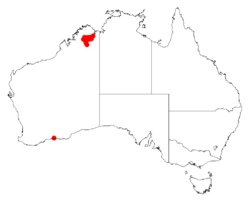Biology:Acacia chrysochaeta
| Acacia chrysochaeta | |
|---|---|
| Scientific classification | |
| Kingdom: | Plantae |
| Clade: | Tracheophytes |
| Clade: | Angiosperms |
| Clade: | Eudicots |
| Clade: | Rosids |
| Order: | Fabales |
| Family: | Fabaceae |
| Subfamily: | Caesalpinioideae |
| Clade: | Mimosoid clade |
| Genus: | Acacia |
| Species: | A. chrysochaeta
|
| Binomial name | |
| Acacia chrysochaeta Maslin
| |

| |
| Occurrence data from AVH | |
Acacia chrysochaeta is a shrub belonging to the genus Acacia and the subgenus Juliflorae that is endemic to a small area of north western Australia .
Description
The shrub is slender and erect typically growing to a height of 1.3 metres (4 ft)[1] with a spindly habit. It has terete, finely veined and densely haired branchlets that are mostly brown but quite yellowish towards the apices. Like most species of Acacia it has phyllodes rather than true leaves. The flat, linear and evergreen phyllodes are pressed closely to the stems and have a length of 2 to 4.5 cm (0.79 to 1.77 in) and a width of 1 to 3 mm (0.039 to 0.118 in). The phyllodes have 1 to 3 mm (0.039 to 0.118 in) long seta that are softy puberulous and have one prominent main vein with multiple parallel minor veins.[2] It blooms between May and June or in October to November producing yellow flowers.[1] The cylindrical flower-spikes have a length of 2.5 to 3 cm (0.98 to 1.18 in) and are densely packed with golden flowers. The narrowly oblong seed pods that form after flowering have fairly straight sides and are straight to slightly curved with a length of 4.5 to 6 cm (1.8 to 2.4 in) and covered with matted golden wooly hairs that age to a white colour. The black seeds inside are arranged obliquely and have an oblong shape with a length of 4 to 4.5 mm (0.16 to 0.18 in).[2]
Distribution
It is native to an area of the Kimberley region of Western Australia.[1] The shrub grows in sandy alluvium especially along watercourses[1] in remote areas from around the Gibb River to around Karungie Station as a part of open Eucalyptus savannah communities.[2]
See also
References
- ↑ Jump up to: 1.0 1.1 1.2 1.3 "Acacia chrysochaeta". FloraBase. Western Australian Government Department of Parks and Wildlife. https://florabase.dpaw.wa.gov.au/browse/profile/3258.
- ↑ Jump up to: 2.0 2.1 2.2 "Acacia chrysochaeta". WorldWideWattle. Western Australian Herbarium. http://worldwidewattle.com/speciesgallery/chrysochaeta.php. Retrieved 27 March 2020.
Wikidata ☰ Q15289683 entry
 |

